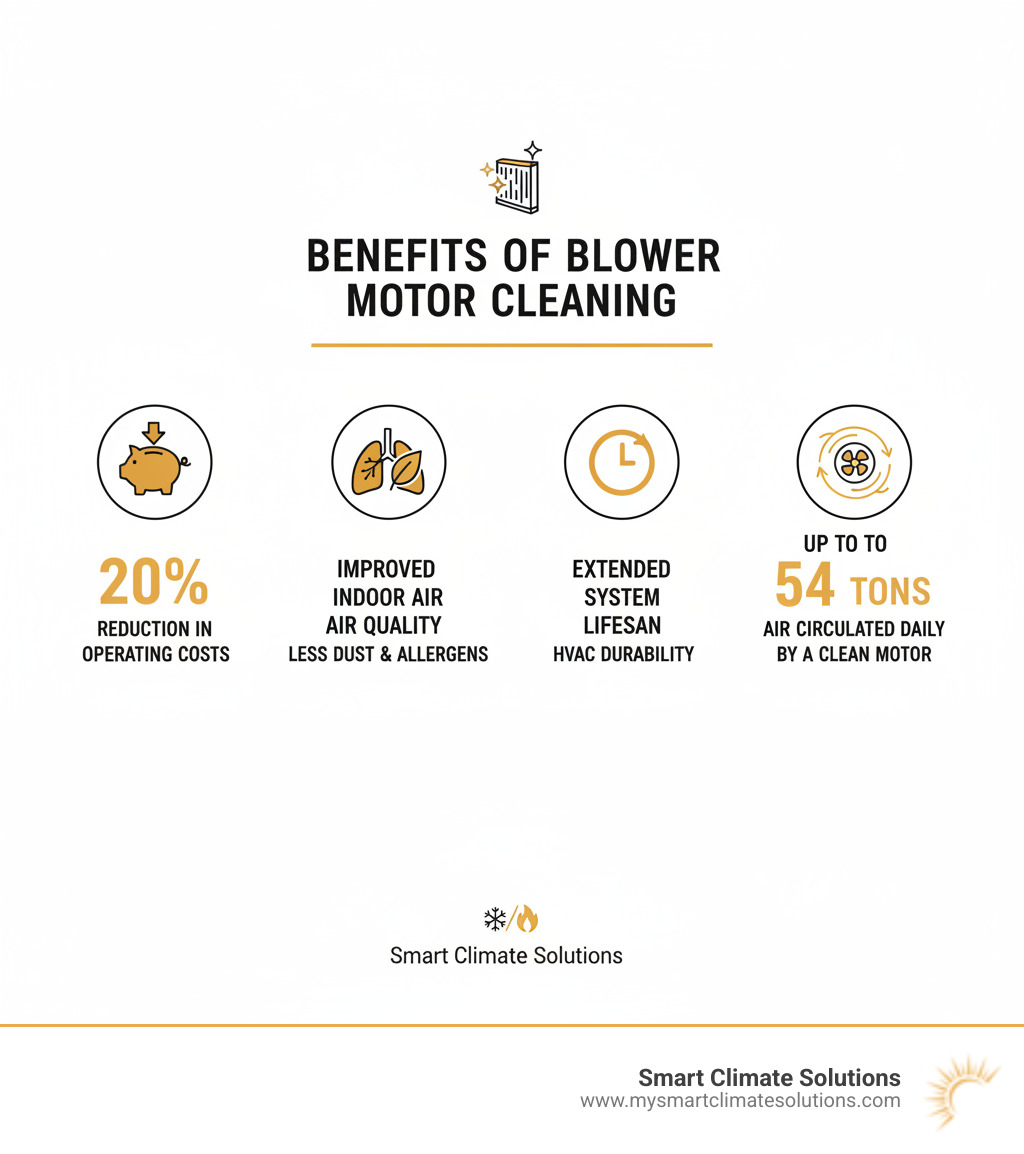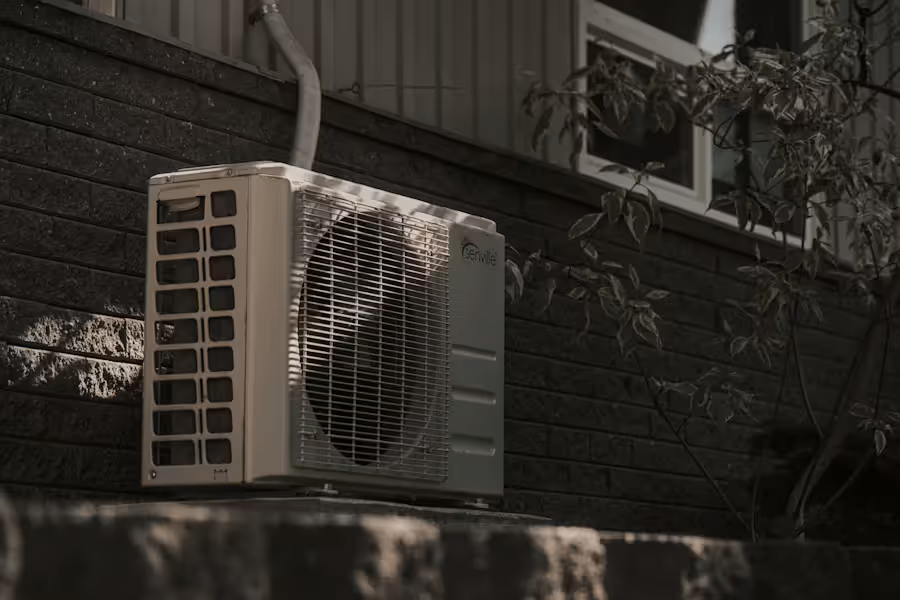Why Your Furnace Blower Motor Deserves a Little TLC
Blower motor cleaning is a critical maintenance task for a smooth, efficient HVAC system. If you're ready to start, here are the quick steps:
Quick Steps to Clean Your Blower Motor:
- Turn off all power to your furnace at the circuit breaker and the furnace switch
- Remove the access panel and locate the blower assembly
- Take a photo of all wiring connections before disconnecting
- Slide out the blower assembly carefully
- Vacuum and brush the blower wheel (squirrel cage) and motor housing
- Wipe down all surfaces with a clean, dry cloth
- Reassemble everything in reverse order and restore power
Your blower motor is the heart of your HVAC system, circulating huge amounts of air. A typical blower can move 1,000 cubic feet of air per minute. If it runs constantly, that's 54 tons of air moving through your home every day.
When dust builds up on the motor and fan, your system works harder to push the same amount of air. This can raise operating costs by up to 20%, harm your indoor air quality, and shorten your HVAC system's lifespan.
The good news is that cleaning your blower motor is a manageable DIY project.
I'm Bill Scott, general manager at Smart Climate Solutions. With over 15 years of experience helping Pittsburgh homeowners with HVAC maintenance, I'll guide you through cleaning your furnace blower motor safely. This will help you enjoy lower energy bills, better air, and a more reliable system.

Why a Clean Blower Motor is Your HVAC System's Best Friend
Think of your blower motor like a car engine. When clean, it runs smoothly. When dirty, it struggles, burns more fuel, and wears out faster. That's what happens inside your HVAC system.
Blower motor cleaning is about protecting your comfort, health, and money. Here's why a clean blower motor is your HVAC system's best friend.
Your Energy Bills Will Thank You
A dirty blower motor works much harder to move air, which increases your electricity bill. Studies show a dirty motor can raise operating costs by 20%. Cleaning it helps your system use only the energy it needs, saving you money.
You'll Breathe Easier (Literally)
The blower motor circulates the air your family breathes. If the fan blades are covered in dust, pet dander, and pollen, those particles get blown back into your home. A clean motor means reduced dust and allergens, less dusting, and healthier air for everyone.
Mold Doesn't Stand a Chance
When dirt and moisture mix inside your HVAC system, it creates a perfect breeding ground for mold. Regular blower motor cleaning keeps the area clean and dry, eliminating the conditions mold needs to grow and spread spores through your home.
Your System Will Last Years Longer
A motor constantly straining against dirt buildup runs hotter and puts stress on other components. This leads to premature wear and expensive repairs or even a full system replacement. Keeping the blower motor clean takes the pressure off, helping your entire HVAC system last longer. For a complete approach, see our Preventive Maintenance Schedule for Air Conditioner.
A Quick Word About Motor Types
There are two main types: single-speed and variable-speed (ECM) motors. Single-speed motors are either on or off. Variable-speed motors adjust their speed based on your home's needs, saving energy. While variable-speed motors handle airflow issues better, both types benefit greatly from regular cleaning. A clean motor is always more efficient.
The bottom line: a clean blower motor works less, costs less, and lasts longer while improving your air quality. That's a friendship worth investing in.
Telltale Signs Your Blower Motor Needs Attention
Your HVAC system will give you signs when something is wrong. Recognizing these signals early can help you avoid expensive repairs. Here are the telltale signs your blower motor needs attention.
One of the first things you may notice is weak airflow from your vents. If the air feels more like a gentle breath than a strong breeze, your blower motor could be struggling under a layer of grime. This can also cause uneven temperatures throughout your house.
Watch for higher energy bills. If your electricity costs are climbing without a change in your habits, your blower motor might be working overtime. A dirty motor can increase operating costs by 20%.
Strange noises are another clear warning. A healthy HVAC system should hum quietly. If you hear humming, rattling, grinding, or squealing, the fan blades may be off-balance due to dirt, or the motor itself is strained.
If you notice excessive dust settling on furniture soon after cleaning, your blower motor might be circulating more dirt than it should.
Musty or burning odors are serious red flags. A musty smell often points to mold, while a burning smell indicates an overheating motor or electrical problem. If you smell something burning, shut the system down immediately and call a professional.
Finally, if your system is cycling on and off frequently, it may be struggling to reach the thermostat setting due to restricted airflow.
Catching these signs early is key. Often, a good blower motor cleaning is the solution. However, if symptoms persist after cleaning, you may need a repair or replacement. Our guide on the Cost to Replace HVAC Fan Motor can help you understand the potential costs.
Your DIY Guide to Blower Motor Cleaning
Ready to clean your blower motor? This guide will walk you through the process step-by-step. It's more straightforward than you might think and a great way to improve your home's comfort and efficiency.
First, let's cover safety.
Essential Safety Precautions First
Working with an HVAC system involves electricity and moving parts, so take these precautions seriously.
Turn off all power to your system. This is critical. Set your thermostat to "Off." Then, go to your main electrical panel and flip the circuit breaker for your furnace or air handler. Many units also have a separate power switch nearby; turn that off too.
Allow your system to cool down for at least 30 minutes if it was recently running to avoid burns.
Wear the right protective equipment. Safety goggles protect your eyes from dust, insulated gloves protect your hands from sharp edges, and a dust mask is smart, especially if you have allergies.
Tools and Materials for Blower Motor Cleaning
Gather your tools before you start:
- Screwdriver or nut driver set
- Vacuum with hose and brush attachment (a shop vac is ideal)
- Soft-bristled brush (an old paintbrush works well)
- Flashlight
- Shop towels or clean cloths
- Smartphone for taking photos
Step-by-Step Blower Motor Cleaning Instructions
Take your time with each step. Doing it right is more important than doing it fast.
Step 1: Access the blower compartment. Find the access panel on your furnace, usually at the bottom. Use a screwdriver or nut driver to remove it. Set the panel and fasteners aside safely.
Step 2: Photograph the wiring. Before disconnecting anything, take several clear photos of the wiring from different angles. This is your guide for reassembly, so don't skip it.
Step 3: Remove the blower assembly. The assembly usually slides out on rails. Carefully disconnect any wiring harnesses and remove the fasteners holding it in place. Gently slide the entire assembly out. It can be heavy, so get a good grip.
Step 4: Clean the blower wheel. This "squirrel cage" fan is where blower motor cleaning has the biggest impact. Use your vacuum's brush attachment to remove loose dust and debris between the blades. Then, use a soft-bristled brush to gently scrub each blade. For stubborn grime, you can use a cloth dampened with mild detergent and water. Crucially, ensure the wheel is completely dry before reassembly to prevent rust.
Step 5: Wipe down the motor housing. Use a clean, dry cloth to wipe the outside of the motor. You can use gentle bursts of compressed air to clear dust from ventilation openings, but don't spray directly into electrical components.
Step 6: Vacuum the compartment. With the assembly out, vacuum the entire compartment to remove accumulated dust and lint.
Step 7: Reassemble and test. Carefully slide the clean blower assembly back into place. Reconnect the wiring, referencing your photos. Replace the access panel. Turn the power back on at the breaker and the furnace switch. Set your thermostat to call for heat or cooling and listen for smooth, quiet operation. You should feel stronger airflow from your vents.
Congratulations! You've completed a key maintenance task that will save you money and improve your home's air quality.
When to Call a Professional Instead
While blower motor cleaning is a great DIY task for many, there are times when it's best to call a professional.
Trust your instincts. If you encounter complex issues, like a blower assembly that won't budge or wiring that seems confusing, it's safer to let an expert handle it. Trying to force things can lead to accidental damage.
If the grime is so stubborn it won't budge with a brush, or if you see rust or corrosion, it's time for the pros. We have specialized cleaning agents and tools to handle tough jobs without damaging your equipment.
Damaged parts are another red flag. Never ignore cracked fan blades or frayed wiring. Operating a system with compromised components can be dangerous. If you spot damage, have a technician inspect it.
If your motor is still making loud noises like grinding or squealing after a thorough cleaning, it likely points to a deeper mechanical problem that requires professional diagnosis.
Finally, if you're simply uncomfortable working around electrical components, there is no shame in calling for help. Your safety is the top priority.
When you call our certified technicians in Pittsburgh, South Hills, Burgettstown, Washington, Steubenville, St. Clairsville, and Weirton, you get more than a cleaning. We perform a thorough inspection, use specialized tools, and apply our Pittsburgh area expertise of over 15 years to catch potential problems early.
For total peace of mind, consider our HVAC Maintenance Plan. We handle all the cleaning and inspections, so you don't have to worry. If you feel out of your depth, we're just a phone call away.
Frequently Asked Questions about Blower Motor Maintenance
As Pittsburgh's HVAC experts for over 15 years, we get a lot of questions about blower motor cleaning. Here are answers to the most common ones.
How often should I clean my furnace blower motor?
We recommend cleaning your blower motor at least once a year, ideally before the main heating or cooling season. However, you may need more frequent cleanings if you have pets, smokers, or are undergoing renovations, as these conditions create more airborne debris. If your system runs constantly or you notice dust building up, it's a good idea to clean it.
Can a dirty blower motor cause my AC to freeze up?
Yes, this is a very common cause of frozen AC units. A dirty blower can't push enough warm air over the indoor evaporator coil. Without sufficient airflow, the coil gets too cold, and moisture freezes on it. This ice buildup blocks even more air, creating a cycle that prevents your system from cooling your home. A clean blower motor ensures proper airflow and prevents this issue.
Is it safe to use chemical cleaners on the blower motor?
We do not recommend chemical cleaners for DIY projects. Harsh chemicals can damage the motor's windings, strip lubricants from bearings, and release fumes into your home's air. For safe and effective blower motor cleaning, stick to a dry brush and a vacuum. For stubborn grime on the fan blades, a cloth lightly dampened with mild detergent is acceptable, but you must dry it completely. For heavy grease or mold, it's best to call a professional.
Conclusion: Protect Your Investment with Proper Maintenance
Your HVAC system is a major investment in your home's value and your family's comfort. Blower motor cleaning is a simple but powerful maintenance task that pays off in better efficiency, cleaner air, and a longer system lifespan. We've covered the warning signs, the steps for a DIY cleaning, and when to call for professional help.
Taking an hour once a year to clean your blower motor can prevent costly headaches. You'll breathe easier with cleaner air, appreciate the lower energy bills, and enjoy the peace of mind that comes from a well-maintained system.
While an annual DIY cleaning is a great habit, professional tune-ups provide even more value. Our certified technicians use specialized tools and their trained eyes to inspect your entire system, catching small issues before they become expensive repairs.
At Smart Climate Solutions, we are proud to serve families throughout Pittsburgh, South Hills, Burgettstown, Washington, Steubenville, St. Clairsville, and Weirton. We provide the fast, reliable service our community deserves. Whether you need routine maintenance or emergency repairs, we are here to help.
Ready to give your HVAC system the professional care it deserves? Schedule your HVAC Service and Repair today, and let's keep your home comfortable all year long.






.png)
